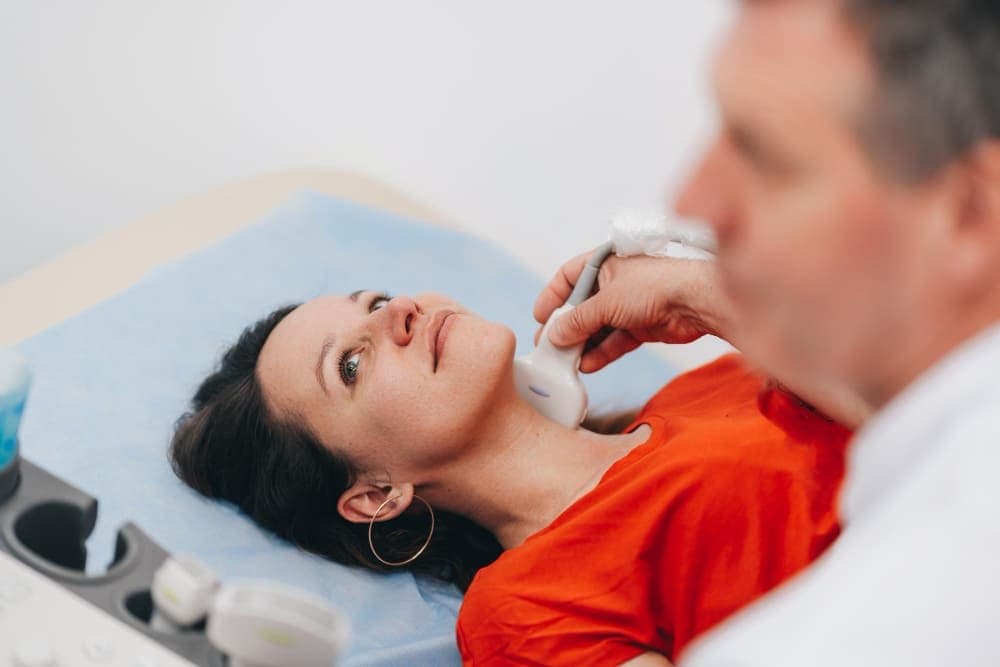When your neck feels swollen or you sense lumps, it’s more than cosmetic — it may signal a multinodular goiter treatment decision. Let’s look at causes, options, risks, and how to choose the right path.

Understanding Multinodular Goiter & Its Challenges
Before diving into therapy, it helps to grasp what we’re treating, and why the size of the goiter or nodules matters.
What Is a Multinodular Goiter?
- A goiter refers to any enlargement of the thyroid gland (goiters).
- A multinodular form (often abbreviated MNG) means there are multiple nodules or lumps inside, not just one.
- In many cases, this condition is nontoxic — the thyroid function remains normal (euthyroid).
- But in some, one or more nodules may turn into a toxic nodule and cause hyperthyroidism (overproduction of hormone).
Why Treatment Becomes Necessary
Treatment is considered when:
- The goiter or nodules grow large enough to cause compression (pressure on windpipe or esophagus), leading to difficulty breathing or swallowing
- Cosmetic concerns — visible neck swelling
- The nodules become toxic, leading to hyperthyroidism
- There is risk or suspicion of cancer
- The patient is symptomatic or has discomfort
In other words, the appropriate treatment of a multinodular goiter varies by symptoms, size, risk, and thyroid behavior.
Evaluation & Diagnosis: What Needs Checking
To pick a safe and effective treatment, your provider must do a comprehensive evaluation, including:
- Medical history & physical exam
- Signs like neck fullness, lumps, hoarseness, breathing issues
- Laboratory tests
- Thyroid function: TSH, free T4, free T3
- Sometimes thyroid antibody tests
- Imaging
- Ultrasound to check each nodule, its size, solidity vs cystic nature
- If hyperthyroidism or toxic nodules suspected: a radioactive iodine scan to see which parts of the gland are overactive
- Biopsy (FNA / core needle)
- To rule out cancer in any suspicious nodule
- Assessment of compressive effects
- If the goiter is substernal (extending into chest) or pressing on nearby structures
This evaluation helps determine whether the goiter is benign, nonfunctional, or has toxic activity, and which treatment options are safe.
General Principles of Treatment
- The goal is to reduce symptoms, shrink growths, preserve thyroid function if possible, and minimize risks.
- No single “best” choice fits everyone — treatment depends on size, number of nodules, thyroid activity, patient preference, and general health.
- Some safe multinodular goiter treatments aim to avoid surgery when possible, especially in patients who prefer less invasive options.
Below I review the main treatment approaches, their pros & cons, and how interventional methods fit in.
Conventional Treatment Options
1. Observation (Watchful Waiting)
- For small, benign, asymptomatic MNG with no compressive features
- Regular follow-up: ultrasound, thyroid tests
- Many patients experience little change over years
- Risks: nodules may grow, become symptomatic, or turn toxic over time
2. Medication & Radioactive Therapies
Antithyroid Medications
- Mainly used if a toxic nodule is causing hyperthyroidism
- Drugs like methimazole or propylthiouracil can suppress hormone excess
- Usually temporary or adjunctive, not definitive in large MNG
Radioactive Iodine (RAI) Therapy
- Uses I-131 to selectively target overactive thyroid tissue
- Can shrink the nodular portion and control toxic activity
- Effects are gradual; may take months
- Risk: too much destruction can lead to hypothyroidism
- In nontoxic MNG, RAI is less often used as primary therapy
3. Surgery (Thyroidectomy or Lobectomy)
- A classic, definitive method when compression is serious or cancer is suspected
- Removes part or all of the thyroid, eliminating nodules and toxic tissue
- Risks: bleeding, nerve injury, hypothyroidism, surgical complications
- Good option when the goiter is larger, obstructive, or extends substernally
Surgery is often the standard when compressive symptoms are severe. But interventional radiology offers alternatives that can reduce invasiveness.
Interventional & Minimally Invasive Treatments
In recent years, technologies have advanced to offer less invasive options. These are especially appealing when patients want to preserve thyroid tissue or avoid open surgery.
Radiofrequency Ablation (RFA)
- A needle probe (guided by ultrasound) delivers heat to destroy nodule tissue
- It shrinks nodules significantly — many studies show volume reduction rates of 65–90% over months.
- Safe profile in experienced hands; complications are uncommon.
- Used for benign solid nodules, compressive symptoms, cosmetic issues, and even toxic ones in select cases.
- In multinodular goiter, RFA can target dominant or symptomatic nodules rather than the whole gland.
- In one study, even extensive MNG was managed with RFA across many nodules.
- Safety is good: most patients have minimal discomfort, less downtime. But nodule regrowth is possible; repeat treatments or surgical backup might be needed.
Microwave Ablation (MWA)
- Similar in concept to RFA, using microwave energy to ablate tissue
- Less well studied, but emerging as another option in the interventional toolbox
- May offer faster heating and larger ablation zones in some scenarios
Thyroid Arterial Embolization
- Involves blocking the blood supply to portions of the thyroid or nodules
- Over time, reduced blood flow leads to shrinkage of tissue
- Useful in selected cases, especially where surgery is risky or parts of the gland are inaccessible
Other Approaches (Ethanol, Laser, Cryoablation)
- Ethanol (alcohol) ablation is used in cystic nodules more than solid ones
- Laser ablation and cryotherapy are less common but may be used on small nodules or in research settings
Comparing Treatment Options: Benefits & Trade-Offs
| Treatment | Ideal Use Cases | Pros | Cons / Risks |
|---|---|---|---|
| Observation | Small, benign, asymptomatic MNG | No intervention, minimal risk | Possible growth, delayed treatment |
| Medication | Toxic nodules as bridge or adjunct | Noninvasive | Often not durable in larger MNG |
| Radioactive iodine | Toxic nodular parts | Can shrink and suppress overactivity | Risk of hypothyroidism, slower effects |
| Surgery | Large, compressive, suspicious MNG | Definitive removal | Invasive, risk of complications, hypothyroidism |
| RFA / MWA / Embolization | Symptomatic, selective nodules | Minimally invasive, fewer risks, preserve function | Need experience, possible regrowth, not suitable for all areas |
The safe multinodular goiter treatments tend to lean toward interventional approaches in appropriate patients — especially those who wish to avoid full surgery.
What Determines Success & Suitability
A few key factors influence which treatment is appropriate and how well it works:
- Size and number of nodules (very large or many may limit ablation)
- Location — if a nodule is too close to the airway, nerves, blood vessels, or in the chest (substernal extension), it may be harder or riskier
- Thyroid function — whether the goiter is nontoxic, toxic, or causing hyperthyroidism
- Patient’s health status, age, surgical risk, and preferences
- Underlying cause — e.g. if iodine deficiency plays a role, correcting diet may help slow growth
- Regrowth risk — no method guarantees zero recurrence
- Quality of imaging and operator experience matter greatly
What Patients Typically Experience & Expectations 😊
- After interventional treatment, many patients notice shrinkage over months, relief of pressure or cosmetic concerns, and fewer symptoms
- Thyroid function often remains stable, especially when intervention is limited to nodules
- With RFA in benign nodules, long-term follow-ups show stable outcomes over many years.
- If the goiter was toxic, hormone levels may improve gradually with treatment
- Some patients will need follow-up imaging, labs, and possibly retreatment
When to Consider Which Treatment: A Basic Guide
- Mild, asymptomatic MNG → observation + regular follow-up
- Moderate nodular enlargement causing cosmetic or mild pressure → consider RFA/MWA or partial intervention
- Significant compression, breathing or swallowing difficulty, or substernal growth → favor surgical or combined approaches
- Toxic nodules / hyperthyroid activity → antithyroid drugs initially, then targeted therapy (RAI, ablation, surgery)
- High surgical risk patients → interventional options become especially valuable
Your health provider, ideally in collaboration with a thyroid specialist and interventional radiologist (like Dr. Samir Abdel Ghaffar), will tailor the plan.
FAQS
1. Can multinodular goiter be treated without surgery?
Yes. Many people with benign multinodular goiter can be managed without surgical removal. Therapy options include radiofrequency or microwave ablation, and in some cases, medication. These methods help reduce swelling, manage growths, and relieve compression or obstructive issues safely over months under medical follow-up.
2. What is the first-line treatment for multinodular goiter?
The first-line treatment depends on thyroid function and clinical presentation. For euthyroid patients, regular monitoring and diet rich in iodine may be enough. In adults with symptomatic or enlarging nodules, minimally invasive therapy such as ablation or radioactive iodine is often recommended before considering surgery.
3. Should a multinodular goiter be removed?
Removal is considered when the goiter develops serious compression on the airway, difficulty swallowing, cosmetic enlargement, or suspicion of thyroiditis or cancer. Evidence shows not every diffuse or substernal goiter needs full removal—management should be discussed with a healthcare provider to choose the safest approach.
4. What is the most common cause of multinodular goiter?
Iodine deficiency is the leading cause worldwide. Over time, the cells of the thyroid grow and form multiple lumps due to genetic and environmental factors, resulting in hyperplasia and colloid buildup. This gradual development often occurs after years of mild hormone imbalance or dietary deficiency.
Key Takeaways & Final Thoughts
- Multinodular goiter treatment is not one-size-fits-all; it must consider size, thyroid activity, symptoms, and risks.
- Safe multinodular goiter treatments are increasingly shifting toward minimally invasive options like RFA, MWA, and embolization when feasible.
- Surgery and radioactive iodine remain important in certain settings, especially for large, obstructive, or suspicious goiters.
- Proper evaluation, accurate diagnosis, and follow-up care are essential to success.
- The key is to balance benefit and risk, aiming to relieve symptoms and manage growth while preserving thyroid function where possible.

 العربية
العربية 
